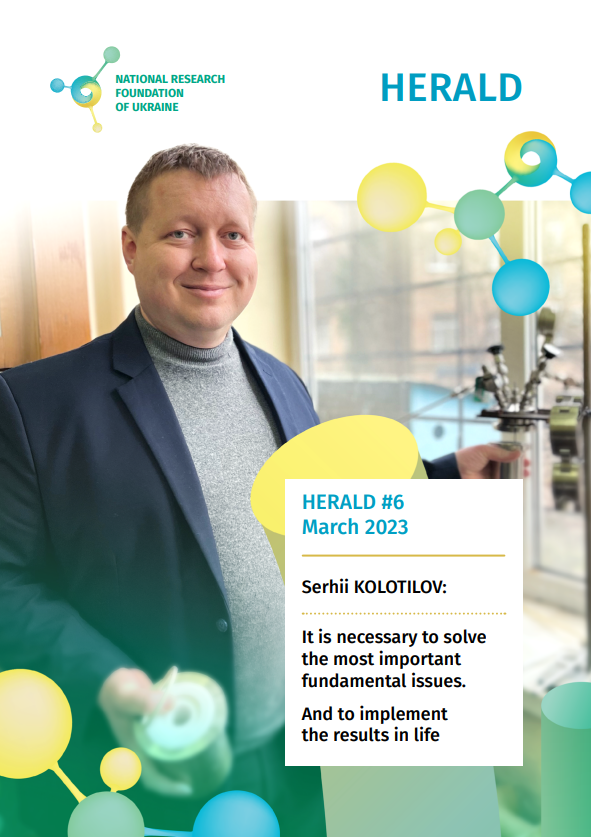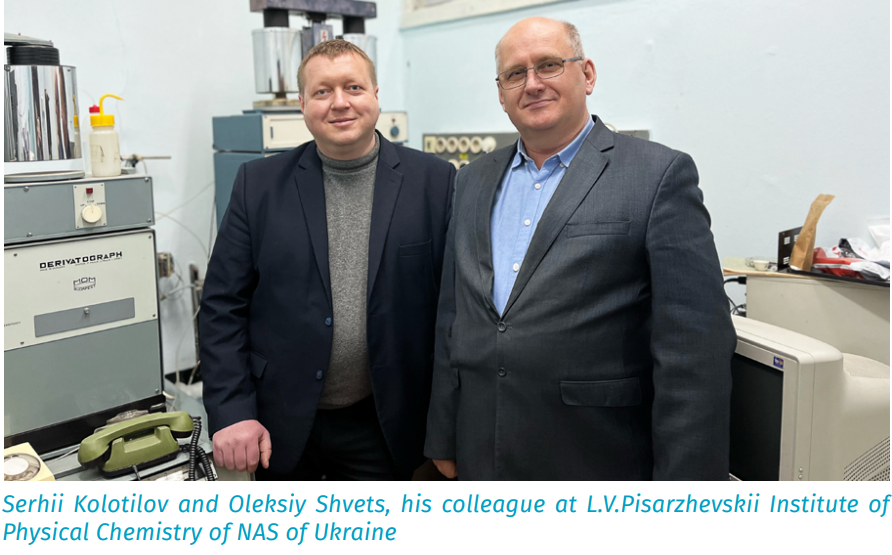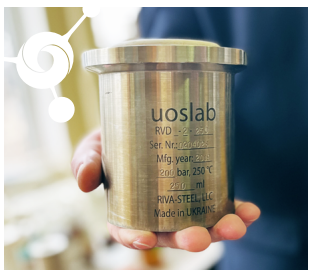
The Borys Paton National Prize is the most important state award of Ukraine which is awarded for outstanding research. Recently, a team of researchers has received this award for their work ‘Creation of organic compounds for modern medicine – an important component of security and defense capability of Ukraine’
In particular, positive feedback from two Nobel laureates in chemistry – Professor Benjamin List (Germany) and Professor Jean-Marie Lehn (France) – is indicative of the high level of this research. The editor of the ‘Science’ journal Dr. Derek Lowe mentioned that the introduction of the Ukrainian product ‘REAL Database’ and the collection of ‘building blocks’ of the Ukrainian company ‘Enamine LTD’ has significantly changed the approaches to the search for new drugs in the global pharmaceutical industry.
One of the researchers on the team is Serhii Kolotilov – Doctor of Chemical Sciences, Acting Deputy Director of L.V. Pisarzhevsky Institute of Physical Chemistry of the NASU, member of the Scientific Council of the NRFU, Chairman of the Scientific Council of the Section of Natural, Technical Sciences and Mathematics of the NRFU. We asked the researcher: what kind of work is it? What makes it important for medicine, security and defense capability of the country?
– Professor, who is part of the team that performed this work? When did you start the research and how long did you work?
– There was no ceremonial start, we have just worked for almost twenty years.
The team that was awarded with the prize consists of eight researchers. Six of them work at Taras Shevchenko National University of Kyiv: Ihor Komarov, Serhii Riabukhin, Pavlo Mykhailyuk, Oleksandr Hryhorenko, Yurii Moroz, Kostiantyn Havrylenko. Two of them – Dmytro Volochniuk and I – work in research institutions of the NASU, in the Institute of Organic Chemistry and L.V. Pisarzhevsky Institute of Physical Chemistry. This is a very strong team! For instance, the sum of the h-indexes of the authors at the time of submission was 194, that is, an average of 25 for each. Honestly, I do not remember such an indicator in the history of state prizes of Ukraine.
– What exactly did you manage to do?
– First, I would like to explain how new drugs are created.
There are several stages of drug manufacturing that can take 10-15 years. The first is the creation of a large array of chemicals from which you need to choose biologically active ones.
First, tens and hundreds of thousands of compounds are tested and groups of molecules that may be promising are identified. Then they are tested again. For example, solutions of substances are dripped into blisters with wells, and a strain of a microorganism is added to them. And then they are checked: in which of these hundred thousand wells the bacterium is alive and in which not. Substances that managed to kill the bacterium are selected for the next stage of screening. Selected compounds are tested with more complex tests.
Out of one hundred thousand compounds, for example, ten molecules can be selected. They will be tested on animals, and the molecules that pass this ‘exam’ go further to clinical trials. At this stage, it is checked if they are effective for the human body.
Such studies are conducted by large pharmaceutical companies, their results are trade secrets.
I want to emphasize: in order for a dozen molecules to reach the finish line, hundreds of thousands of compounds must be synthesized at the first stage. That is, someone has to prepare, synthesize and transfer these compounds to pharmaceutical companies for further research. This work is very important (critical), since without primary screening there will be neither preclinical and clinical studies nor a new drug.
By the way, there should be many more than one hundred thousand compounds at the start. A pharmaceutical company should be able to study the catalog and select substances according to the necessary criteria. If a drug against cancer is created, some compounds are chosen, others are chosen to reduce blood pressure.
– One hundred thousand compounds is a lot… It is difficult to imagine how long it takes to create them…
These figures are not as tremendous as it seems at first glance. For example, you have a compound that consists of three components: A, B, C. You develop a method for obtaining one new component A, then you take from the composition a thousand already known compounds of group B and a thousand known compounds of group C. As a result, you will get a million new compounds ABC – of course, if all reactions are successful.
That is, it is not difficult to propose a million new compounds, for this you need to create only one new compound A and effective methods for carrying out reactions A + B + C. The resulting compounds replenish the composition, and the next series of molecules can be synthesized with them.
But in real life, this is a rather complicated task. Let’s imagine that there is a chemist who has to perform the synthesis. This person has to weigh the substance, load it into a flask, and carry out the reaction. This work will take 2-3 hours. Even if you do several syntheses simultaneously and work without a rest, you can isolate one or two dozen substances per working day.
That is why it is important to develop methods for the creation of large sets of chemicals that allow to obtain all the combinations A + B + C from the above example with high efficiency and probability of success, and to spend a minimum of time and effort on the selection of special conditions for each reaction. This task was solved in our work.
– What else was done in the framework of the research?
– We worked in three directions: The first one – we developed new effective methods for the synthesis of chemical compounds.
The second – we created the world’s largest (!) database of compounds that can be quickly synthesized. And we also developed algorithms for processing the database with which you can select compounds that are promising for biological research.
Our database includes 4 billion compounds. Pharmaceutical companies analyze the database, give orders for certain compounds, and chemists synthesize the very substances required by the customer. These compounds are offered by the Ukrainian company ‘Enamine LTD’, one of the world leaders in this field.
The third direction – we developed devices for chemical reactions and established the production of these devices (autoclaves, reactors, photochemical reactors, reactors for working with the most dangerous gases and toxic substances) in Ukraine. These devices are manufactured in the LLC ‘Riva-Stal’ in Kyiv.
– Which direction in this work is yours? 
– My contribution to the common cause is the creation of new catalysts for the synthesis of organic compounds and the creation of sorbents for the separation of organic compounds (including optical isomers).
These catalysts are needed to create so-called flow reactors. A significant part of the work is devoted to the development of these reactors.
Imagine that a chemist conducts the reaction A + B: takes a flask, loads these compounds, prepares their solutions, conducts the reaction, and purifies the mixture. The portion of the substance that can be created at one time is limited by the volume of the flask.
If you have a flow reactor in which you can mix these substances, you can get a lot of product (theoretically – an unlimited amount). You only need to add the incoming solutions and take the substance that is formed.
The flow reactor has many advantages: it can work for a day, a week, a month and synthesize tens or hundreds of kilograms of substance. For a pharmaceutical manufacturer, this amount can be enough for years of work, because one pill contains milligrams of active substance.
To carry out fine organic synthesis processes in flow reactors, new heterogeneous (i.e. solid, insoluble) catalysts are needed (if new portions of solutions pass through a layer of the same catalyst, its consumption will be lower and the product will be purer than when the catalyst is dissolved in the reaction mixture).
To purify the products, sorbents are needed to separate the substance. We have proposed new chiral sorbents (from the Greek word “chiros” – hand) for chromato graphic separation of optically active compounds. Chiral substances (optical isomers) are compounds of the same atomic order which differ like mirror reflections. In most reactions they have very similar properties. But not in all! One isomer may have a useful biological activity and the other may have a harmful one. One of the most famous examples is ethambutol which is used to treat tuberculosis. If you take its ‘mirror twin’, the substance will cause blindness. That is, if you do not separate these isomers and synthesize a substance with impurities of an undesirable antipode, then simultaneously with the treatment of tuberculosis, the patient will have problems with vision.
The synthesis of large batches of sorbents for the separation of chiral compounds was tested at the enterprise ‘Catalysis and Ecology’ of L.V. Pisarzhevsky Institute of Physical Chemistry of the NASU.
Of course, the award is also the merit of my colleagues. Based on the results of these studies, three PhD theses were defended at L.V. Pisarzhevsky Institute of Physical Chemistry of the NASU. These are the dissertations of Yulia Satska (dedicated to the separation of optical isomers) and the work of Anton Lytvynenko and Svitlana Sotnik (dedicated to the creation of heterogeneous catalysts for various processes).
I want to emphasize that my contribution is only 1/8 of the work that was awarded the Borys Paton Prize. What I did would not be worthy the state award without the contribution of all the team members.
– One of the most difficult questions of Ukrainian science: “How to implement research results into manufacture?”. Do I understand it correctly that the results of this work were successfully implemented in manufacture?
– This is one of the most difficult questions of both Ukrainian and world chemistry.
But still I want to emphasize: the reader may get the impression that the implementation of the results is our ultimate goal. This is not quite true.
Without fundamental research there can be no scientific progress, and there will be no understanding of how to solve applied problems! Properly formulated tasks of fundamental research lead to results that are the basis for further applied developments.
In order to implement research results, it is necessary to ask manufacturers what they need. That is, you need to do not what is interesting to you, but what is needed by manufacturers.
In Ukraine there are chemical companies, world leaders in the field of high-tech chemical production – in cooperation with which we have done this work – ‘Enamine LTD’, ‘Ukrorgsyntez LTD’ and others. These enterprises synthesize substances for customers, international pharmaceutical companies.
Our team performed both fundamental research and at the same time implemented methods for the synthesis of substances required by pharmaceutical companies.
Based on the substances obtained, many components of medicines have been developed and introduced. The total export volume of products and related services from Ukraine to Europe and North America, created due to the implementation of the work in Ukraine, in 2021 alone exceeds UAH 2.7 billion (this is confirmed by the relevant acts from RPE ‘Enamine LTD’ and RPE ‘Ukrorgsyntez LTD’).
The feedback on our work, which was received by the Committee of State Prizes of Ukraine in Science and Technology, contains letters from domestic manufacturers of medical products ‘JSC Farmak’, ‘Microkhim’, ‘Biopharma’, from employees of the world-famous companies Bayer AG and Merck Healthcare KGaA.
The detailed list of developments for which there are acts of implementation takes several pages, but most of the obtained practical results are trade secrets of manufacturers. Let me remind you that we primarily made new compounds for medications discovery, not final drugs.
– The title of the work that received the prize states that it is an important component of security and defense capability of Ukraine. What makes it important in this sense?
– Thanks to the implementation of the results of our research, about 2000 jobs have been created at the RPE ‘Enamine LTD’ and RPE ‘Ukrorgsyntez LTD’. These are world-class specialists who can solve the most complex issues. All of them work in Ukraine and this is a real counteraction to the ‘brain drain’ from our country. The formation of a team that can solve complex research problems is no less important than the domestic production of new substances for medications.
By the way, the work of ‘Enamine LTD’ and ‘Ukrorgsyntez LTD’ is important not only for Ukraine. After the full-scale russian invasion, the world’s leading publications – ‘Bloomberg’, ‘The Wall Street Journal’, ‘Endpoint News” – wrote that the termination of the activities of these Ukrainian companies may suspend or significantly slow down the discovery of new medicines around the world. According to John F. Hartwig, laureate of the Centenary Prize of the Royal Society of Chemistry (RSC), Wolf Prize, Arthur C. Cope Award, the work ‘Creation of organic compounds for modern medicine – an important component of the security and defense capability of Ukraine’ has become one of the greatest contributions to improving the position of the Ukrainian industry of fine organic synthesis in the world market and to the development of manufacture of products with high added value in Ukraine.
– Professor, how often during these many years of work did you run into a dead end? And how did you get out of it?
– This is an absolutely common situation. In my postgraduate years, I counted that only 20 percent of my syntheses were successful…
It is very simple. You must work more, then successful attempts will give so many research materials that there will not be enough time to describe them in the form of articles. If you work hard, a new problem will arise – you will have to choose the most interesting results to describe in articles and postpone less interesting ones to free up time for new discoveries.
– Each victory is also success of the teachers who brought the person to science and helped to develop in it. Who are your teachers?
– My teacher is academician Vitalii Pavlishchuk. I have known him since school age (of course, he was not yet an academician back then), he helped me prepare for Chemistry Olympiads, then he was the supervisor of my PhD thesis and consultant of my doctoral thesis. Much of what I know and am good at, I got thanks to him. Although this does not mean that I always agreed with him.
I am also grateful to the scientific school of L.V. Pisarzhevsky Institute of Physical Chemistry of the NASU, where they are very attentive to the conclusions validity, correctness and logic of the wording. I am grateful to the teachers of the Faculty of Chemistry of Taras Shevchenko National University of Kyiv, as well as to our partners from ‘Enamine LTD’ who gave us the opportunity not only to implement the developments, but also to gain important experience in practical result-oriented work.
– I can’t help asking: what were the first months of the war for you?
– From February 25 to mid-May, I was in our institute around the clock. Together with my colleagues we monitored the territory, checked the documents of people who went down to the shelter.
In early March, a blast wave broke about sixty windows in the buildings of the institute. Of course, we could not allow heating pipes to freeze or devices to be damaged. My colleagues and I were looking for plywood and promptly closed and glazed these windows.
We also established contact with the local territorial defense and were ready for any development of events. We are still ready for this.
– What, in your opinion, are the arguments for becoming a researcher today? What would you say to young people?
– It is interesting and promising. You are unlikely to become a millionaire in this profession, but if you work hard, you will provide yourself with a decent life. And most importantly – you will be able to do interesting (captivating!) and important work all your life.
Interviewed by Svitlana GALATА

